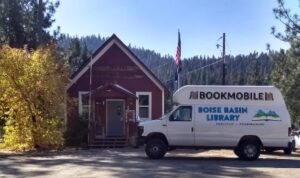
This article was written by Heidi Ambrose, who works in Albertsons Library’s access services unit. Ambrose worked for the Boise Basin Library District in Idaho City for several years. She has unique insight into the evolution of bookmobiles in rural Idaho, and their importance to communities across Idaho.
National Bookmobile Day is celebrated every April 26. This is an homage to these “libraries on wheels” that ensure small towns have access to books, educational materials, computers, the internet, classes and connection to resources — all at no cost.
A physical library building is most often used by those living nearby. For communities with a large rural population, access to the library may not be available. This is where the bookmobile comes into play.
The bookmobile has traditionally been a resource for print material. Also, a lot of libraries have implemented a “story time” feature when their bookmobile is at a remote location. This has served rural communities well. However, just like the physical library, changes in service needs create opportunities for both the library and its patrons.
Print material is no longer the main reason for patrons to visit their library. Libraries have evolved into modern learning spaces. Libraries are featuring maker spaces, podcasting booths, video editing software, workshops and technology.
In order to support the library’s changing role, the bookmobile also started implementing programming to the rural community. Partnering with community events to provide STEM (science, technology, engineering and math), art, storytelling and books, too.
The community of Lowman has a population of 44. Because of the mountain location, most of the community does not have access to a library. The one-room schoolhouse hosted 10 students last year, kindergarten through fifth grade.
When the bookmobile started its outreach to small communities like Lowman, it was a source for print material and story time at the schools, and for families who who home-school. But the families in these communities couldn’t access the programming available to other library patrons in the district. The library recognized that this small population was their target audience. There was a need to support children in rural, underserved, and often impoverished, communities.
The library asked, “What can the bookmobile do to stimulate learning, thinking, creativity, ingenuity and more?” Monthly visits to the schoolhouse, reading a story, and checking out some books seemed like we weren’t doing enough. So then we asked, “Where and when can we reach out to these students to provide them with better programming opportunities?”
The answer came after attending a fundraising event in one of these small towns. The whole community seemed to be in attendance. The library got the idea to piggy-back on other local events. We called volunteer fire departments, community clubs and any other organizations we could think of. We partnered with organizations at their events and offered a variety of STEAM (science, technology, engineering, art and math), cooking classes, adult art projects, free books and literacy information.
At first, the library really focused on STEM. However, the students were already inundated with tech. They wanted to make crafts and create art. We added these, as well as some mobile cooking and gardening classes for senior centers. A few times a year the bookmobile brought some maker technology for the kids to experience. With all the options we provided, it was fascinating that the favorite activity for both adults and kids was the shadow puppet theater!